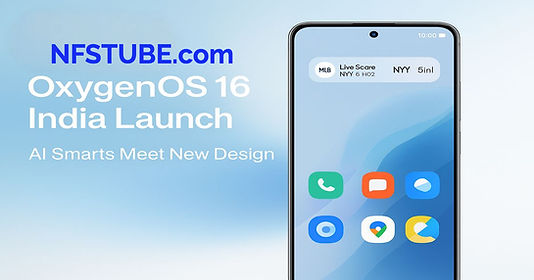
OxygenOS 16 Deep Dive: How Gemini AI and Cross-Platform Connectivity Redefine the Android Experience
The world of Android is in a constant state of flux, driven by a relentless pursuit of innovation that extends far beyond Google’s core operating system. Each year, manufacturers like OnePlus layer their unique vision on top of the latest Android release, creating custom experiences that aim to be smarter, faster, and more intuitive. The latest industry-shaking development comes with the announcement of OxygenOS 16, a landmark update built upon the foundation of Android 16. This release isn’t just an incremental upgrade; it represents a significant philosophical shift. By deeply integrating Google’s powerful Gemini AI into its core functionalities and boldly tearing down the walls between competing ecosystems, OxygenOS 16 offers a compelling glimpse into the future of personal computing. This article provides a comprehensive technical analysis of this groundbreaking software, exploring its core features, real-world applications, and the profound implications it holds for the entire Android landscape.
The New Pillars of OxygenOS 16: AI, Customization, and Connectivity
OxygenOS 16 is built on three foundational pillars that collectively aim to create a more intelligent and seamless user experience. These pillars are not isolated features but interconnected concepts that redefine how a user interacts with their device and the broader digital world. The latest Android news highlights a clear trend towards on-device intelligence, and OnePlus is positioning itself at the forefront of this movement.
The AI Core: Gemini Powers “Mind Space”
The centerpiece of this update is the radical evolution of Mind Space, a feature that transforms from a simple utility into a proactive AI-powered workspace. Initially launched as a tool for saving and analyzing screenshots, Mind Space in OxygenOS 16 becomes a multi-modal contextual hub. Users can now capture long, scrolling screenshots of web pages or conversations and record 60-second voice memos to add verbal context to their saved items. The true game-changer, however, is the deep, native integration of Google’s Gemini AI. This isn’t a simple chatbot integration; Gemini now has the ability to understand, synthesize, and act upon the entire collection of information a user saves in their Mind Space, turning a passive collection of data into an actionable knowledge base.
A Fresh Coat of Paint: Advanced Customization and UI Refinements
Responding to a growing demand for personalization, OxygenOS 16 introduces a vastly more flexible lock screen customization suite. Drawing inspiration from the granular controls introduced in Apple’s iOS 16, users can now adjust fonts, colors, and the layout of widgets with unprecedented freedom. This allows for the creation of unique lock screens that are both aesthetically pleasing and functionally rich. Aesthetically, the OS introduces a new “Optical Light” effect, a subtle, glowing animation that appears in certain UI elements like the notification shade or volume slider. This effect provides a fluid, almost tangible feel to interactions, reminiscent of high-end motion design principles. Underneath these visual changes, OnePlus promises the signature smooth performance and fluid animations that have long been a hallmark of the brand, now further optimized for the new hardware in flagship Android phones.
Breaking Down Walls: The Connectivity Push
Perhaps the most surprising and ambitious pillar of OxygenOS 16 is its aggressive push for cross-platform interoperability. Through an enhanced “O Plus Connect” application, OnePlus is actively building bridges to ecosystems traditionally considered rivals. The update enables seamless tap-to-share functionality for photos between a OnePlus or Oppo phone and an iPhone, a feature that addresses a long-standing pain point for users in mixed-device households. In another bold move, the software now allows an Apple Watch to connect for basic notification syncing, providing a level of integration previously unheard of. Furthermore, the remote control feature, which already supported Macs, has been expanded to include Windows PCs, making the smartphone a true central hub for managing all of a user’s primary computing devices.
Under the Hood: How Gemini Transforms Mind Space into a Proactive Assistant
To truly appreciate the innovation in OxygenOS 16, it’s essential to look beyond the surface-level features and analyze the technical mechanics of the new Mind Space. The integration of Gemini represents a fundamental shift from reactive data extraction to proactive information synthesis, making it one of the most advanced AI implementations seen on any smartphone to date.

From Passive Capture to Active Intelligence
The previous iteration of Mind Space operated on a simple, linear model: a user saves a screenshot, and the software uses Optical Character Recognition (OCR) to extract basic information, such as text or a date, to suggest a calendar entry. The new model is exponentially more powerful. It accepts multi-modal inputs—scrolling screenshots, high-resolution images, and transcribed voice notes—to build a rich, interconnected database of a user’s intentions and interests. Gemini’s role is to act as the central nervous system for this database. It doesn’t just see a flight confirmation; it sees the flight, the hotel you screenshotted earlier, the restaurant review you saved, and the voice memo where you mentioned “find a kid-friendly activity.” It understands the semantic relationship between these disparate pieces of information, allowing it to function less like a tool and more like a genuine assistant.
Real-World Application: Planning a Complex Project
Consider a professional, like a marketing manager, planning a new product launch. Their workflow might look like this:
- They save scrolling screenshots of competitor analysis reports from a web browser.
- They capture images of inspirational ad campaigns from social media.
- They record a 60-second voice memo after a team meeting: “Key takeaway: focus on the 18-25 demographic and highlight the eco-friendly materials. Budget for digital ads is capped at $50,000.”
- They save a screenshot of a project management timeline from a web app.
Technical Considerations and Best Practices
This powerful functionality raises important technical and privacy questions. A key consideration is whether the data processing occurs on-device or in the cloud. For privacy-conscious users, on-device processing is preferable, though complex synthesis tasks may require cloud computing power. Users should also be aware of the potential for AI misinterpretation. The quality of the output is directly proportional to the quality of the input. A best practice for maximizing Mind Space’s effectiveness is to be descriptive and clear. When saving a screenshot, adding a quick voice memo like “This is the final vendor quote to use for the budget” provides invaluable context that the AI can leverage for more accurate and helpful results.
Beyond OnePlus: What OxygenOS 16 Signals for the Future of Android
The features introduced in OxygenOS 16 are more than just a selling point for a single brand; they are a bellwether for the entire mobile industry. These advancements put pressure on competitors and highlight emerging trends that will likely define the next generation of Android phones and Android gadgets.
The Race for Smarter, More Personal AI
Google has long been a leader in ambient AI on its Pixel devices, with features like “At a Glance” and “Call Screen” that work passively in the background. OnePlus is taking a different, more user-directed approach. Mind Space is an active, curated environment where the user explicitly feeds the AI with relevant information. This creates a new competitive dynamic: which AI model is more useful—the one that anticipates your needs based on ambient data, or the one that acts on the specific data you’ve deemed important? This move will undoubtedly spur Samsung, Google, and others to accelerate the development of their own context-aware AI assistants, pushing the boundaries of what a smartphone can do.
The End of the Walled Garden? A New Era of Interoperability

For years, the tech industry has operated on a “walled garden” principle, where ecosystems are designed to work seamlessly within themselves but poorly with competitors. The cross-platform connectivity features in OxygenOS 16 represent a significant crack in those walls. By enabling photo sharing with iPhones and basic connectivity with the Apple Watch, OnePlus is acknowledging the reality that many consumers live in a mixed-device world. This user-centric approach could become a major differentiator. While the underlying technology likely relies on proprietary protocols within the O Plus Connect app rather than a new universal standard, it sets a powerful precedent. It signals to the market that true convenience means working with the devices users already own, regardless of the logo on the back.
The Customization and User Experience Arms Race
The renewed focus on deep lock screen customization demonstrates that the battle for user experience is far from over. As hardware specifications on flagship Android phones begin to plateau, software-based personalization is becoming a key battleground. Manufacturers can no longer compete solely on processor speed or camera megapixels. The fluidity of animations, the intuitiveness of the UI, and the ability for a user to make their device truly their own are now paramount. OxygenOS 16’s refined aesthetics and customization options are a clear indication that the software experience is just as important as the hardware it runs on.
Should You Be Excited? Weighing the Pros and Cons
OxygenOS 16 is an ambitious and feature-rich update, but its advanced capabilities may not be for everyone. Understanding its strengths and potential drawbacks is key to deciding if it aligns with your needs.
The Ideal User Profile

This update will most strongly appeal to power users and organizational enthusiasts. Individuals who frequently manage projects, plan events, or conduct research will find the Gemini-powered Mind Space to be an indispensable tool for collating and synthesizing information. Furthermore, users who operate in a mixed-device environment—perhaps using a OnePlus phone, a Windows laptop for work, and an Apple Watch for fitness—will see immense value in the new connectivity features that bridge these disparate ecosystems.
Potential Drawbacks and Considerations
With great power comes a potential learning curve. Unlike passive AI features, Mind Space requires a conscious behavioral change to be effective; users must actively remember to save relevant information. Secondly, the advanced AI processing and sophisticated animations could potentially have a greater impact on battery life and system resources, particularly on older devices that will receive the update later. Finally, users must be comfortable with the privacy implications of allowing an AI to process their curated data. While security measures are undoubtedly in place, the concept of a centralized, AI-analyzed information locker will be a key consideration for some.
Recommendations for Users
For current OnePlus owners, the best approach is to wait for the stable release and read long-term reviews, unless you are an enthusiast comfortable with the potential instability of an open beta. For those in the market for new Android gadgets, the upcoming OnePlus 15, which will launch with OxygenOS 16, is shaping up to be a formidable contender, especially if its core AI and connectivity features align with your personal or professional workflow.
Conclusion: A New Benchmark for the Android Experience
OxygenOS 16 is far more than a simple annual refresh. It is a bold statement about the future of the smartphone, envisioning a device that is not just a tool for communication and consumption, but an intelligent partner in our daily lives. By weaving the formidable power of Gemini AI into a user-curated space, OnePlus has created a uniquely personal and proactive assistant. By simultaneously extending a hand to competing ecosystems, it champions a user-first approach to connectivity that prioritizes convenience over corporate rivalry. This update sets a new standard for what a custom Android skin can achieve, blending raw power with thoughtful intelligence and deep personalization. It’s a clear signal that the most exciting Android news is no longer just about hardware; it’s about the software that makes that hardware truly smart.



